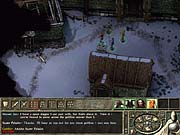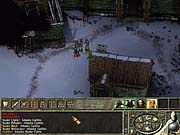Icewind Dale II Preview
We take an updated look at Black Isle's upcoming RPG, which will use the 3rd Edition Dungeons & Dragons rules.
In the wake of this year's blockbuster role-playing games, including Neverwinter Nights, Morrowind, and Freedom Force, it may be difficult to look away from your monitor, much less all the way back to the year 2000. That was when veteran RPG developer Black Isle Studios released its last Dungeons & Dragons game for the PC. The original Icewind Dale was a hack-and-slash RPG that drew inspiration from noted fantasy author Robert "Bob" Salvatore's Icewind Dale trilogy of novels, which featured the epic adventures of the gallant and disgustingly overpowered fantasy hero Drizzt Do'Urden. But both the frigid reaches of the Forgotten Realms and the equally frigid nerds of Black Isle Studios' own message boards have demanded that the developer create a sequel, and the long-awaited, oft-delayed Icewind Dale II will be the result.

Icewind Dale II will be a game of firsts and lasts. For instance, the developers have stated in numerous interviews that the sequel will most likely be the last game for which Black Isle will use the BioWare Infinity engine. The Infinity engine is the same 2D sprite-based graphics engine that Black Isle used for Icewind Dale and Planescape: Torment and the same engine that developer BioWare created for Baldur's Gate and Baldur's Gate II. Icewind Dale II will default to a screen resolution of 800x600 and, like Baldur's Gate II before it, will support even higher video resolutions (up to and past 1024x768), but it's clear that the Infinity engine is on its last legs and has been for some time. However, Icewind Dale II will, along with Neverwinter Nights, be among the first computer games to use the revised 3rd Edition Dungeons & Dragons rules. The 3rd Edition makes characters more interesting and more powerful, since it not only lets them become proficient with weapon skills, but also with noncombat skills and new abilities called heroic feats, which let characters run faster, attack their enemies multiple times, and make their magic spells longer-lasting and more powerful. What's more, 3rd Edition rules let characters actually increase their physical abilities--in previous Dungeons & Dragons games, a warrior with a strength score of 15 was stuck with that 15 for the rest of his life. The 3rd Edition rules let that fighter gain more strength as he gains experience levels, and with the bonuses that some races receive, some characters can even begin their lives with an ability of 20 points--the powerful half-orc race can begin with a whopping strength score of 20, for instance. Icewind Dale II will also include the 3rd Edition barbarian, monk, and sorcerer character classes.
We've been able to play through only the opening of the game, which takes place around 30 years after the events of the first game. We find that the Ten Towns of Icewind Dale are besieged by goblin raiders, much like in the beginning of Salvatore's novels. Your party of characters is a band of mercenaries that sails into the town of Targos in search of work, only to find the town already under attack. As in the Icewind Dale trilogy, Icewind Dale II's Ten Towns are small, isolated, mostly autonomous trading posts that rely on the commerce of scrimshaw--the carved bone of the indigenous knucklehead trout. And just like in the novels, the towns themselves are often at odds with each other over trade issues, and as we found, the vicious goblin attacks and the subsequent influx of strange mercenaries like your own party, have only worsened the distrust among the towns' inhabitants--those that haven't been killed in the attacks yet, anyway.

Fortunately for the towns, your adventurers arrive before the goblins have leveled everything, and in the first few areas of the game, they can clear out some goblins and perform a few simple quests. The combat system in Icewind Dale II resembles that of the previous game, but it has a more refined and complex interface. Fights still take place in real time, and you can still pause the game with the space bar and use special abilities tied to your function keys (F1, F2, and so on), but you can also create custom hotkeys for your characters' new special abilities or for your favorite spells. As we've seen, the highly damaging power-attack and cleave feats can wreak utter havoc on the numerous but relatively weak goblins of Icewind Dale, especially when they're being used by a raging half-orc barbarian with a high strength score.
A New Way to Hack and Slash

Though Icewind Dale II will be mostly focused on challenging combat, it will also have numerous quests that your characters can perform for rewards of experience points, money, or items or some combination of all three. Like in Black Isle's other RPGs, you'll sometimes be able to perform optional quests simply by virtue of your character class. For instance, early on in the game, you'll meet a wounded soldier of Targos, whom you can heal for an experience reward if you have a character with the ability to use healing magic. To get your quests, you'll want to make sure you speak with every character you meet, and Icewind Dale II uses the same sort of dialogue system as the previous games: You can ask questions and choose your responses from a simple list. Many of the conversations you'll have in Icewind Dale II will give you the opportunity to choose a benevolent "good" response, a neutral response, or a selfish "evil" response. And depending on your character's skills, you may be able to access new dialogue options that will let you attempt to deceive or intimidate the person you're speaking to.
You can choose these and other skills when creating a new character, and thanks to Icewind Dale II's expanded character options and wider variety of races and classes, making new characters seems like it'll be even more engaging than it was in previous Dungeons & Dragons games. Fortunately for players who don't like sitting around and rerolling dice, Icewind Dale II doesn't use random dice rolls like Icewind Dale and the Baldur's Gate games. Instead, the sequel uses the weighted point-buy system: a system that lets you spend character points on whichever attributes you like and that may give your character some bonuses and penalties, depending on your race.
Icewind Dale II has a much larger pool of character races to choose from, including subraces for each major race. Elves can be wild elves, moon elves, or even drow elves; dwarves can be shield dwarves, gold dwarves, or gray dwarves. Gnomes can be rock gnomes or deep gnomes. Halflings can be lightfoots, stronghearts, or ghostwises. Humans can be purebred human, half-fiend tieflings, or celestial aasimar. And you can also choose to play as a half-elf or half-orc. Each of these races has advantages and disadvantages. For instance, drow elf characters receive bonuses to their dexterity, intelligence, and charisma, as well as an innate form of magic resistance, but they receive a weighty penalty that's known in the 3rd Edition rules as an "effective class level" penalty: They advance experience levels more slowly than other races, specifically as if they were two levels lower. Most of the character races seem more or less balanced--even the races that have interesting and powerful abilities have suitable penalties, so choosing your characters' races will really be a matter of personal preference more than anything else. And as in the previous Icewind Dale, you'll be able to start with a band of up to six adventurers, but you can certainly play with fewer--doing so means that your fights will be tougher, but you'll get more experience to divide among your characters.

Choosing good characters for your party will be important to your success in Icewind Dale II, but the game's character system seems to be flexible enough to allow for some error. You're going to want to choose a few solid frontline warriors--fighters, barbarians, or paladins; a magic-user of some kind, such as a wizard or sorcerer; some sort of healer, such as a cleric or druid; and a character with thieving skills, like a rogue. But since Icewind Dale II uses the free-form 3rd Edition rules, you're free to distribute skill points and take different heroic feats to balance out your characters and even help them fill out other roles in the party. For instance, you might want your paladin character to invest skill points in the diplomacy skill in order to get the best results when speaking with other characters. Or, you might want your bard character to invest skill points into the search and disarm device skills in order to find and disarm traps, sort of like a surrogate thief. What's more, in Icewind Dale II, just as in the 3rd Edition rules, any race can be any character class--you can make whatever bizarre race-class combination you desire.
And with a few exceptions, you can also freely multi-class your characters--that is, choose a class for your character, then when that character advances a level, choose a different character class. If you so desire, you can create a barbarian/rogue/sorcerer/ranger--a useful character with a lot of skills, but one that will be weaker in a fight than a character that simply chose to be a fighter and remained a fighter for several experience levels, gaining fighter-related skills and feats. You'll want to consider the trade-off between depth (having a character advance in a single class and becoming much more powerful in that class) and breadth (having a character take multiple classes), but from what we've seen so far, this trade-off seems fair. If nothing else, all these choices will lend Icewind Dale II additional replay value, as zealous players will want to go through the game with a new party and develop different skills. Fortunately, players who might not want to deal with this huge variety will also be able to choose to play as one of five different and well-balanced pregenerated parties that will ship with the game.
Even though the first few areas are all we've seen from Icewind Dale II, the game itself seems quite playable, and creating new and interesting characters seems like it may be a game in itself. Black Isle has also gone to some trouble to clean up the game's interface--there's a lot more information to keep track of for each character, but just as in Icewind Dale, it's all lined up in a number of clean-looking menus. Icewind Dale II is shaping up to be a game that Dungeons & Dragons fans everywhere should definitely consider playing when it's released later this year.
Got a news tip or want to contact us directly? Email news@gamespot.com
Join the conversation